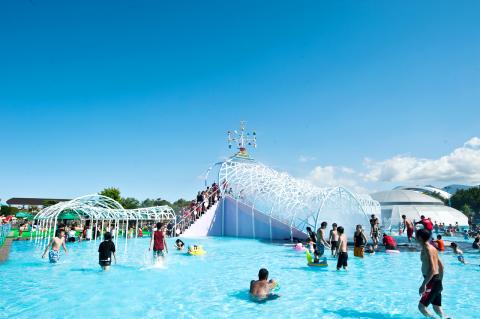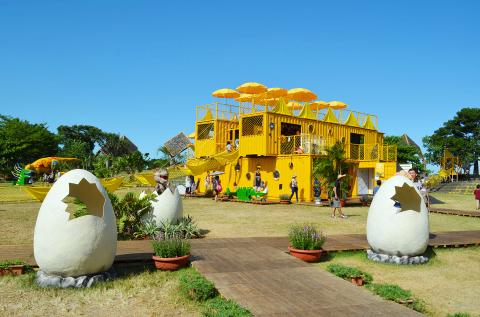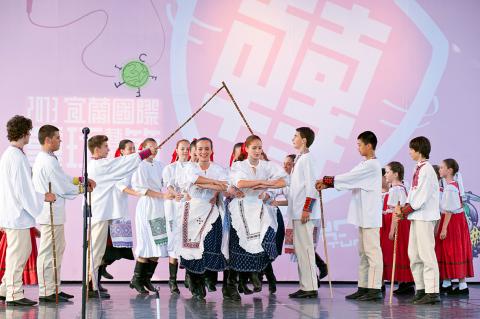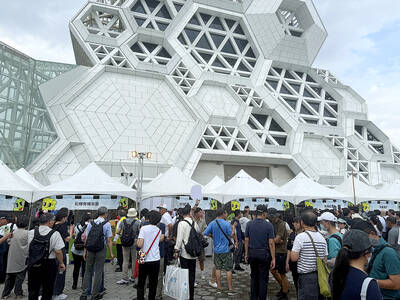This year, the Yilan International Folklore and Folkgame Festival comes of age as it celebrates its 18th birthday with a bigger than ever event. It opened July 6, and despite a slight hiccup in the festivities as a result of Typhoon Soulik last weekend, it is now back on track celebrating all aspects of childhood.
The folklore and folkgame festival has grown in scope, and has proven to be one of the Yilan County Government’s most successful ventures, perfectly timed for the summer holidays when parents around the country are looking for child-friendly activities. This year, the festival has settled on “change” (轉) as its theme, and has sought new inspiration from a variety of sources to make the festival even more lively and appealing.
Most notably, the festival now has a large Internet presence, which opens the door on seven cartoon characters that have been specially created for the festival by designer Xiao Qing-yang (蕭青陽), who has come up with some of the most memorable album cover designs for Taiwanese musicians and is a four-time Grammy nominee for Best Recording Package. According to Cheng Jing-wen (鄭景文) of the Cultural Bureau of the Yilan County Government, “the cartoon characters are an important addition to how the festival presents itself.”

Phots courtesy of the Yilan County Government
Playing in the water of the various water features of the Dongshan River Water Park (冬山河親水公園) has always been a key element to the festival. This year, the focus will be on the newly created Space Vortex Water Shoot (星際水漩渦) and the eye-catching Spinning Water World (轉動水世界). The always popular upside-down maze (倒轉水迷宮) and other play facilities will also be on hand.
The presence of the festival as an international event has also been upped by the inclusion of two major artists who have contributed their talents. The first is internationally renowned illustrator Jimmy Liao (幾米), who has been commissioned to create a play area in which children can become a character in one of his books and explore a fantasy world of his creation. The second is Japanese architect Terunobu Fujimori, who has also been brought in to create a DIY experience that is intended to show children how natural materials can be used.
As in previous years, a host of performance groups from overseas and some of Taiwan’s best local groups have been invited to perform. Of the 18 countries that have sent groups to participate in the festival, six will be first-time participants.

Photo courtesy of the Yilan County Government
In the interactive section of the festival, many experts in the making of handmade toys and local craftsmen will be on hand to show children that toys can be made from readily available materials, and that they can make toys that are unique to themselves. The festival, which runs until Aug. 25 and is open daily from 9am to 5pm, takes place at the Dongshan River Water Park located at 2 Chinghe Rd Sec 2, Wuchieh Township, Yiland County (宜蘭縣五結鄉親河路二段2號). Tickets are NT$250 on weekdays and NT$350 on weekends. Extensive information about the many activities taking place are available on the festival Web site at www.yicfff.tw.

Photo courtesy of the Yilan County Government

Following the shock complete failure of all the recall votes against Chinese Nationalist Party (KMT) lawmakers on July 26, pan-blue supporters and the Chinese Communist Party (CCP) were giddy with victory. A notable exception was KMT Chairman Eric Chu (朱立倫), who knew better. At a press conference on July 29, he bowed deeply in gratitude to the voters and said the recalls were “not about which party won or lost, but were a great victory for the Taiwanese voters.” The entire recall process was a disaster for both the KMT and the Democratic Progressive Party (DPP). The only bright spot for

Water management is one of the most powerful forces shaping modern Taiwan’s landscapes and politics. Many of Taiwan’s township and county boundaries are defined by watersheds. The current course of the mighty Jhuoshuei River (濁水溪) was largely established by Japanese embankment building during the 1918-1923 period. Taoyuan is dotted with ponds constructed by settlers from China during the Qing period. Countless local civic actions have been driven by opposition to water projects. Last week something like 2,600mm of rain fell on southern Taiwan in seven days, peaking at over 2,800mm in Duona (多納) in Kaohsiung’s Maolin District (茂林), according to

Aug. 11 to Aug. 17 Those who never heard of architect Hsiu Tse-lan (修澤蘭) must have seen her work — on the reverse of the NT$100 bill is the Yangmingshan Zhongshan Hall (陽明山中山樓). Then-president Chiang Kai-shek (蔣介石) reportedly hand-picked her for the job and gave her just 13 months to complete it in time for the centennial of Republic of China founder Sun Yat-sen’s birth on Nov. 12, 1966. Another landmark project is Garden City (花園新城) in New Taipei City’s Sindian District (新店) — Taiwan’s first mountainside planned community, which Hsiu initiated in 1968. She was involved in every stage, from selecting

The latest edition of the Japan-Taiwan Fruit Festival took place in Kaohsiung on July 26 and 27. During the weekend, the dockside in front of the iconic Music Center was full of food stalls, and a stage welcomed performers. After the French-themed festival earlier in the summer, this is another example of Kaohsiung’s efforts to make the city more international. The event was originally initiated by the Japan-Taiwan Exchange Association in 2022. The goal was “to commemorate [the association’s] 50th anniversary and further strengthen the longstanding friendship between Japan and Taiwan,” says Kaohsiung Director-General of International Affairs Chang Yen-ching (張硯卿). “The first two editions